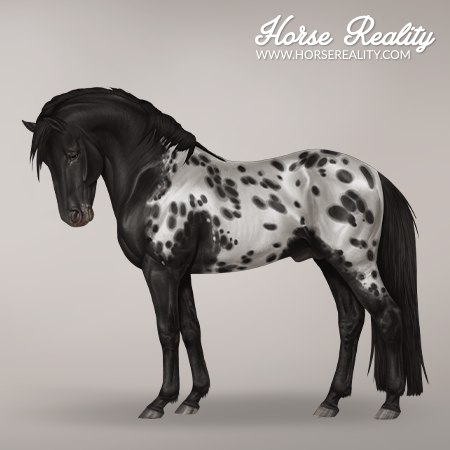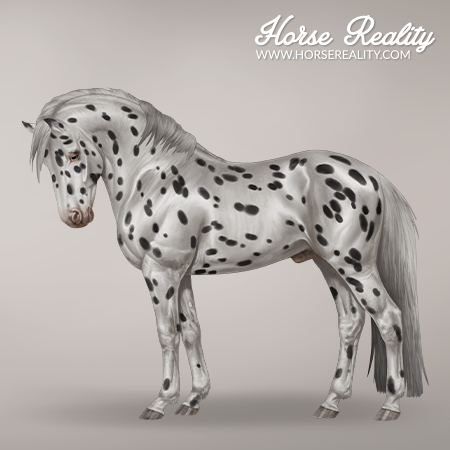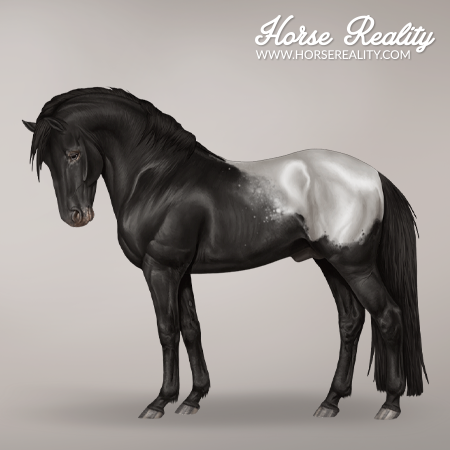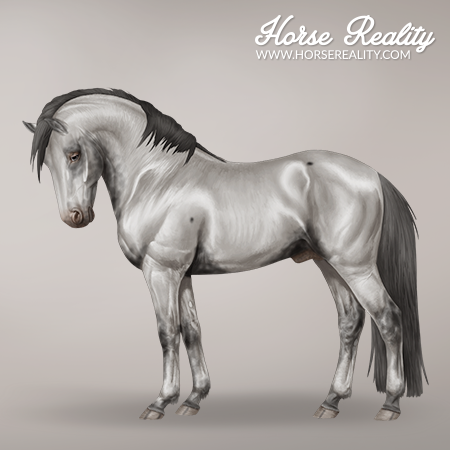Leopard Complex is a group of related white patterns present in horses. Even though they are present in several different breeds, the patterns are also often called "appaloosa" or “appaloosa spotting", named after the breed most famous for its colour.
¶ Phenotype
The leopard complex causes a wide range of different white patterns. The different leopard complex patterns can be classified as white patches with or without pigmented spots known as leopard spots, and “roaning” (progressive loss of pigment with age). They are called a “complex” because even though they visually look very distinct from each other, they are all genetically related. The three most important characteristics of the leopard complex are:
- Mottled skin: Mottled skin consists of small dots on the skin of the anus, genitalia, mouth, and eyelids. On pink skin, these are pigmented, while on dark skin they are pink or white.
- Stripped hooves: Striped hooves refer to vertical bands of pigment on unpigmented hooves.
- White sclera: A white area around the pupils.
Some horses may lack one or more of the traits at birth, but over time they will gradually appear on nearly every horse within this complex of related patterns. The leopard complex patterns may also cause colour shifting, which can make the underlying coat colour of the horse look different from what would be expected based on genetics. The different leopard complex patterns can be classified as follows:
| Leopard Complex - Knabstrupper | |
| Example | Information |

|
Varnish roan Varnish roan horses are born with the colour determined by their genes, usually with some spotting and typical leopard complex characteristics. As the horse ages, white hairs increasingly appear over most of the body. Many of the spots that were originally present eventually fade out. This differentiates the pattern from “true roan”, as this similar-looking white pattern does not increase with age. The bony parts of the horse (bridge of the nose, cheeks, points of the shoulder, knees etc., legs) retain pigment for longer. A typical characteristic of varnish roan is a V-shaped coloured area on the nose of the horse. These coloured points help distinguish the pattern from roan. |

|
Spotted blanket A spotted blanket can be characterised by a solid white area, or “blanket”, filled with leopard spots covering the hip and croup area of the horse. The blanket can have crisp clean, flecked edges, or “roaned” edges. The size of the blanket may vary from being very small to covering a large part of the horse. Very big spotted blankets are also called near-leopard. |

|
Leopard A leopard horse is nearly completely “white”, with leopard spots covering the entire body. The leopard spots usually have a distinct orientation that makes it look like they flow out from the flank, towards the rest of the body. Leopard horses may retain areas of residual colour on the flanks, neck, and head, but these often fade “varnish out” as they age. |

|
Snowcap blanket A snowcap blanket can be characterised by a solid white area with very few or no spots in it covering the hip and croup area of the horse. |

|
Few spot Few spot horses have a nearly entirely “white” body, with very few (usually on the head or low on the body) or without any pigmented leopard spots. They may also retain areas of residual colour on the flanks, neck, and head, which may fade as they age. |
¶ Genotype
The different leopard complex patterns are a result of the leopard complex (LP) gene and its modifiers, pattern-1 (PATN1) and pattern-2 (PATN2). These 3 genes work together to create a wide variety of patterns. The exact genetics causing the patterns are not yet fully understood in real life. Pattern-2 is not a testable gene in real life but has been implemented in the game as a way to account for the unknown genetic causes of certain patterns.
¶ Leopard Complex (LP)
The LP-allele, which is the core of all leopard spotting patterns, is located on the TRPM1 locus. Without any copies of LP, a horse won't have a leopard complex pattern. It is an incomplete dominant allele; homozygous horses will have little to no leopard spots (possibly leading to snowcap or few spot phenotypes), while heterozygous horses normally do have leopard spots (possibly leading to spotted blanket or leopard phenotypes).
TRPM1 plays an important role in the cell signalling that enables night vision. LP disrupts the normal functioning of this gene and as a result, horses homozygous for leopard complex (LP/LP) also have congenital stationary night blindness (CSNB). Horses with CSNB are unable to see in low-light conditions. Horses with two copies of LP have also been shown to have an increased risk for equine recurrent uveitis (ERU) which is a progressive condition and the leading cause of blindness in horses.
Horses that are homozygous and heterozygous for the LP-allele will both vary in the amount of white area that is present, as this is controlled by different genes. These genes are called modifier genes. Some may increase the amount of white, while others decrease it. When no or little white area is present, this leads to varnish roan patterns. An increase in white area leads from snowcap or spotted blankets, to eventually few spot or leopard phenotypes.
Leopard complex can be tested at the Laboratory. There, it is named “appaloosa”.
¶ Pattern-1 (PATN1)
Pattern-1 also called “first pattern modifier”, is a modifier with the largest positive influence on the amount of white. In-game, horses that are homozygous for the PATN1-allele will be leopard or few spot. Horses that are heterozygous for PATN1 will have large (near leopard) spotted blankets or snowcap blanket patterns. PATN1 will only affect the coat when the horse also has 1 or 2 copies of the LP-allele.
Pattern-1 can be tested at the Laboratory.
¶ Pattern-2 (PATN2)
Pattern-2, or “second pattern modifier” is a hidden gene in Horse Reality.
In real life, pattern-2 was once theorised to be the “blanket gene”. This theory has since been abandoned; however, it is still believed that modifiers other than pattern-1 exist but have not yet been discovered. In the game, the PATN2-allele creates smaller spotted blankets and snowcap blanket patterns. PATN2 will only affect the coat when the horse also has 1 or 2 copies of the LP-allele.
Pattern-2 is untestable and may therefore be the reason why a horse that tests negative for PATN1, still shows a spotted blanket or snowcap blanket pattern.
The table below lists the resulting phenotype of each genotype. Pattern-2 has not been included, since it is a hidden gene.
| Leopard Complex (LP) | Pattern-1 | Phenotype |
| LP/_ | patn1/patn1 | Varnish Roan |
| LP/lp | PATN1/patn1 | Spotted Blanket / Near Leopard |
| LP/lp | PATN1/PATN1 | Leopard |
| LP/LP | patn1/patn1 | Varnish Roan |
| LP/LP | PATN1/patn1 | Snowcap |
| LP/LP | PATN1/PATN1 | Fewspot |
¶ Breeds
Leopard complex is a very old mutation and is present in various horse breeds as a result. The following table lists all breeds that can currently have the leopard complex patterns in-game.
| Breeds |
| Akhal-Teke Horse |
| Arabian Horse |
| Brabant Horse |
| Brumby Horse |
| Camargue Horse |
| Cleveland Bay |
| Exmoor Horse |
| Finnhorse |
| Fjord Horse |
| Friesian Horse |
| Haflinger Horse |
| Icelandic Horse |
| Irish Cob Horse |
| Kladruber Horse |
| Knabstrupper |
| Lipizzaner Horse |
| Lusitano |
| Mongolian Horse |
| Mustang Horse |
| Namib Desert Horse |
| Noriker Horse |
| Norman Cob |
| Oldenburg Horse |
| Pantaneiro Horse |
| Pura Raza Española |
| Quarter Horse |
| Shetland Pony |
| Shire Horse |
| Suffolk Punch |
| Thoroughbred |
| Trakehner Horse |
| Welsh Pony |
¶
References
- Bellone R., Sponenberg D. P., Equine Color Genetics, 4th Edition, 2017, Wiley-Blackwell
- UC Davis Veterinary Genetics Laboratory; https://vgl.ucdavis.edu/test/leopard-complex; Access: December 2022
- Bellone, R.R., et al, Evidence for a Retroviral Insertion in TRPM1 as the Cause of Congenital Stationary Night Blindness and Leopard Complex Spotting in the Horse, 2013